
views
Since kitchen knives will be an investment that is used daily for all your cooking days, selecting good quality ones that have durability, strength, good handling, and endurance is a must. In this article, you'll learn what to look for when you go shopping for quality kitchen knives.
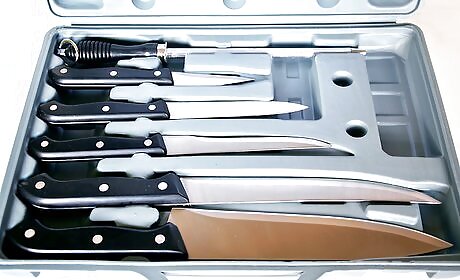
Before setting out to purchase knives, consider the type of knife you will need in your kitchen. Available in a wide variety of shapes and sizes, kitchen knives can meet a huge variety of needs, and the extent of knives needed depends on your cooking style and habits. A good basic kit for an average domestic kitchen would include: An all-purpose utility knife (13cm / 5 inches) – used for a range of foods; often a choice for the first knife as it can do many things. A chef's knife (20-23cm / 7.8–9 inches) – used for chopping, dicing, mincing, and cutting. A vegetable or paring knife (8cm / 3") – used for peeling, cutting, and trimming small items of food that you hold in the hand (such as trimming small potatoes). A bread knife (serrated) – used for bread, cake, fruit, and tomatoes. A cleaver – used for meat, and a smaller version for chopping herbs, etc. Only buy if you need to chop serious pieces of meat. A filleting knife – helps to fillet fish. Only buy if you intend on filleting; most people don't bother anymore but buy food ready filleted. A carving knife – used for getting thin and even slices of meat from roasts, full roasted poultry, etc. Sharpening steel, knife-honing stone, or electric honer. Quite often you can buy a knife set which may contain much or all of this range; often these will be cheaper than buying them individually, but the same rules outlined in the following steps should still apply to picking a good set of kitchen knives. Also, the risk with buying a cheap or prepackaged box set is that you might not like the feel of each knife in the set, or grow to dislike the brand, whereas if you had trialled simply one knife first, you can quickly change to another brand if that one doesn't work for you.
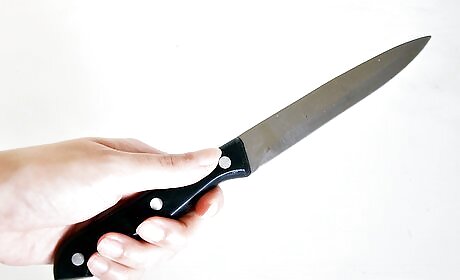
When buying knives, hold each knife in your hand. If you are going to be using this tool, the grip should be comfortable and sit well in your hand. Be aware that what one person finds comfortable does not necessarily mean it will be comfortable for you, so while advice is helpful, do a first hand test for yourself.
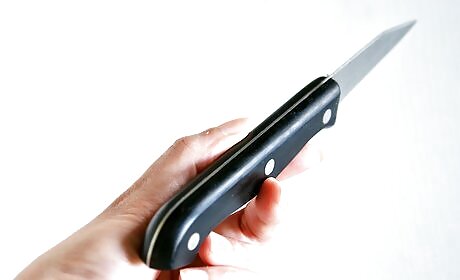
Look at how much steel is in the knife as well as where it is located. Look for any signs of joining or welding, particularly in the hilt of the knife. This is a weak point in the knife and should be avoided as weak knives are more likely to bend or break at this joining point. The best knives are made from a single piece of steel, hand-forged (although these are rare and often cost prohibitive), while cheap knives tend to be thin with insubstantial hilts and handles covered thickly in plastic.
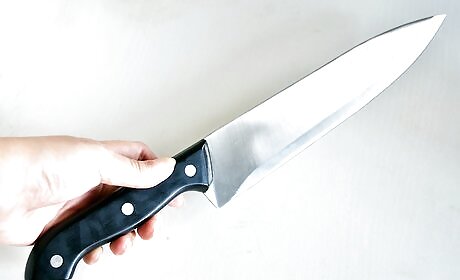
Feel the weight of the knife. A lightweight chopper is good for speed and precision, whereas a heavy knife requires far more work in using it for chopping a lot of light ingredients. However, the opposite applies where solid foods such as nuts, fresh ginger, palm sugar and other harder ingredients are being chopped; for these, a heavy knife is ideal.
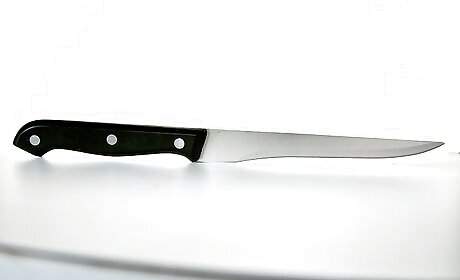
Examine the balance of the knife. Quality knives tend to have very good balance with not too much weight either in the blade or the handle. The old fashioned way to test is to place your finger at the finger grip at the hilt or blade-end of the handle, holding the knife horizontally with the cutting edge down. A quality, well balanced knife will balance at that point and not fall off your finger. Naturally, utmost care should be taken when doing this test! Only very expensive and high quality manufacturers consider the balance so most knives will simply fall off your finger. The key reason to consider balance is that a well balanced knife makes any cutting action easier and requires less effort. It is essentially the leverage point – like a seesaw's balance – and it has to be at a specific point or it is unbalanced. If you are using the knife a lot for large quantities of ingredients, a balanced knife offers far less strain on the arm.
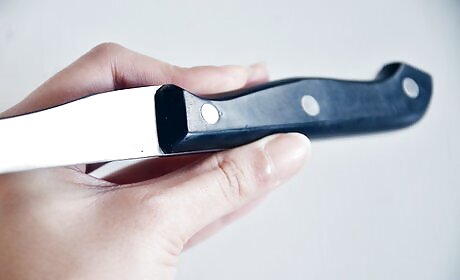
Look at the hilt of the knife. It should be solid, easy to clean and well joined. For most knives it is the most solid part of the knife as it is like a conduit where the strain of pressing on the handle travels through into the blade. If it is thin, is not evident (such as covered in plastic), or there is evidence of a weld or join, then it is not a good sign. If you can see any gap, not only will this increase the weakness of the knife but it can also trap minute portions of food and breed bacteria.
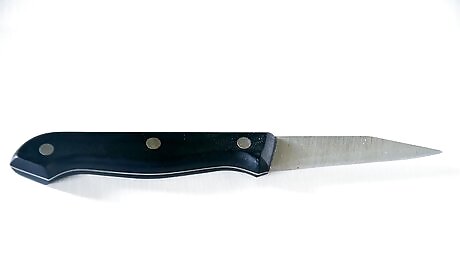
Consider the material the handle is made from. The handle is often made of wood, plastic, toughened resins and other strong materials. Old fashioned bone handled knives are not a good choice as bone becomes brittle after time. There have been several cases where an antique knife's bone or wood handle has crumbled in the user's hand, causing injury. Low density or soft woods or other low density materials are not recommended for knife handles.
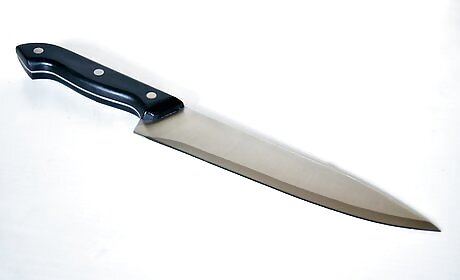
Consider the blade itself and what it is made of. Arguably the best knife blade is ceramic as it can be sharpened to scalpel quality, hold its sharpness for a long time and does not rust. The key drawback is this type of knife is extremely fragile and can break with ease – and good ones are often prohibitively expensive. Cheap ceramic knives should be viewed with high caution. Good knives are often made of non-stainless steel (carbon steel), which gives a good edge fairly quickly, but care should be taken so they will not rust. Carbon steel knives are easy to sharpen at home but need vigilance to prevent rusting. Stainless steel is what many cheap modern knife blades are made of, but they often tend to go blunt quickly and take a very long time to sharpen again. Aim to purchase high-carbon stainless steel knives; they require sharpening but they won't rust. With less carbon content than rust-prone older carbon steel knives, these ones hold their edge better and are harder. If you're on a budget, an inexpensive stainless steel is a good choice until you can afford a high-carbon stainless steel knife. Forged blades are better than stamped ones because the forging renders the metal stronger. Avoid knives that claim to never need sharpening. They are not very sharp to begin with and they cannot be sharpened, meaning that when they lose their edge (and they will), they have to be disposed of.
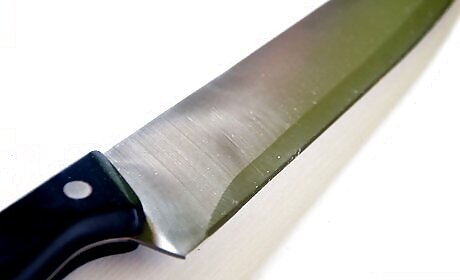
Look at the width of the cutting edge. As well as the thickness and smoothness of the blade. The best knives are smooth as though polished with no sign of pitting in the metal. The cutting edge should run the full length from tip to the hilt. The image to the right shows the last 1.5cm (0.59") or so has no cutting edge at all, so would be useless for heavy cuts such as carrots, which is what the larger knives are often needed for. Serrated chef's knives should be avoided for general use such as vegetable and meat chopping as they can be very unsafe, being more likely to slip than cut. They cannot be sharpened and they saw rather than slice, unless you apply direct downward pressure (like when cutting a block of hard cheese) which is dangerous. It sounds like a good deal and is often packaged or advertised as an all-in-one knife that both chops vegetables, etc., and cuts bread, but they are not worth the money. You almost never see them in a knife set from a quality manufacturer, so it can be quite indicative the manufacturer is targeting a customer looking for what seems the most economical option. Serrated knives should be included in your set but only for slicing bread or baked products.
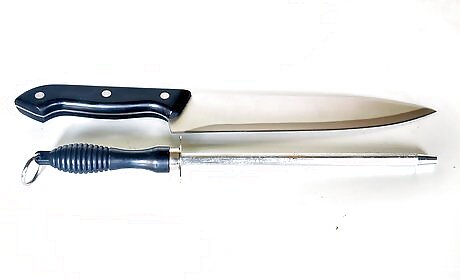
Maintain your knives in good, sharp condition. For a good quality set, also invest in a steel and a sharpening stone. The steel maintains a nice cutting edge, but will not give the knife one if it has gone blunt without a lot of work. Stones will restore an edge or improve an existing cutting edge. A diamond steel can cost a lot more, but will give a very fine edge. They also wear the knife down faster so knives can start to take a curved or sickle shape if care is not taken when sharpening. Very often people sharpen the middle of the blade on a steel, which also often happens most when you sharpen it with high speed (as it can look impressive to sharpen knives that way). Take it slowly and evenly the whole length of the blade, so it wears and sharpens evenly. Do not use the knife on stone, glass, steel or ceramic cutting boards or surfaces; this can damage the knife and put fine chips in your food as well as being more likely to slip and cause an injury. Wood or rigid (not flexible) plastic is still the best cutting board. The board must be cleaned regularly and if plastic soaked in a 10:1 water and bleach solution once a week in high-use environments on top of regular cleaning. Most knife handling injuries are caused by blunt knives rather than sharp ones as more pressure is applied to cut and the knife is more likely to slip. Be sure to use a sharpener that's meant for the blade material so you don't damage your knives.
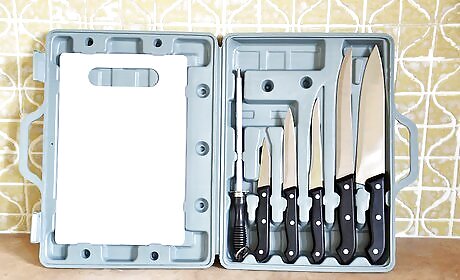
Focus more on quality and not brand. Of course your aim is to get good quality products at cheaper rates. Be it from high brand or from low brand, after all you have to make the payments. Try not to let anyone else use your knives if they are your personal set. Ultimately the most knife injuries where bluntness was not the cause was someone using a knife with which they were unfamiliar.
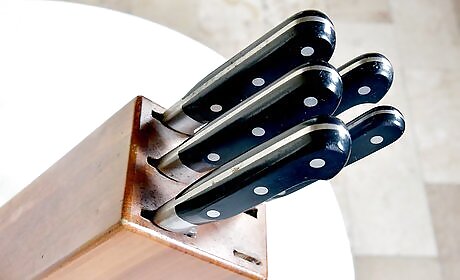
Store your knives carefully. A knife block is fine, so is a knife roll which is a cloth pouch much like a roll of spanners or wrenches. Some knives come in their own storage box, but many chefs simply wrap the knives in an old apron (ensuring no knife touches another) for storage, with the apron strings securely wrapping the bundle so it does not fall open. Magnetic knife strips are not as ideal, but are fine in an environment where there are no children and should be installed where they will not be knocked and fall off. Storing them loose in a toolbox or utensil drawer is not recommended.

Shop around for your knives. The internet can be excellent to find good prices from quality brands and many hospitality wholesalers have buy-direct websites to get robust knives at a very good price. However, be sure to have at least visited a store to get a feel for the knives you want to buy online, or be sure that there is a good returns policy in case you don't like the feel of the knife on receipt. Knives are an investment as a good set can last many years (20 to 30 years or more) so it is best to choose one will last and work well for you as well as making cooking far easier and more enjoyable.




















Comments
0 comment